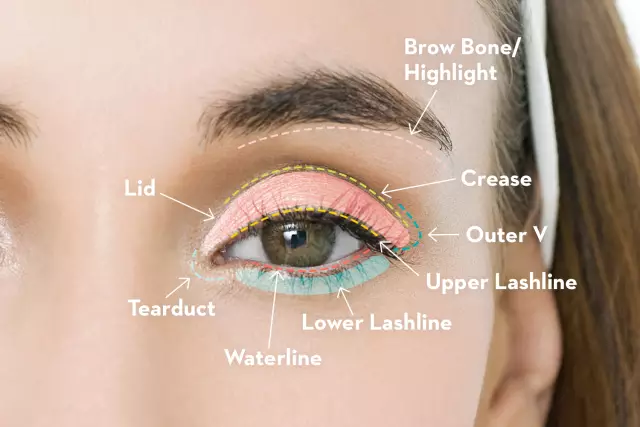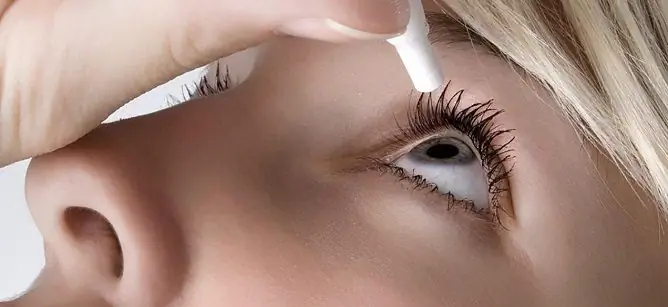- Author Rachel Wainwright [email protected].
- Public 2023-12-15 07:39.
- Last modified 2025-11-02 20:14.
Irifrin
Irifrin: instructions for use and reviews
- 1. Release form and composition
- 2. Pharmacological properties
- 3. Indications for use
- 4. Contraindications
- 5. Method of application and dosage
- 6. Side effects
- 7. Overdose
- 8. Special instructions
- 9. Use in childhood
- 10. Drug interactions
- 11. Analogs
- 12. Terms and conditions of storage
- 13. Terms of dispensing from pharmacies
- 14. Reviews
- 15. Price in pharmacies
Latin name: Irifrin
ATX code: S01FB01
Active ingredient: Phenylephrine (Phenylephrine)
Manufacturer: PROMED EXPORTS, Pvt. Ltd. (India)
Description and photo update: 2019-12-08
Prices in pharmacies: from 426 rubles.
Buy

Irifrin is a drug with alpha-adrenergic action used in ophthalmology.
Release form and composition
Irifrin is produced in the form of eye drops 2.5% and 10%: a clear solution from light yellow to colorless (5 ml each in dark glass bottles complete with a dropper or plastic dropper bottles, 1 dropper bottle or bottle in a cardboard pack).
The composition of 1 ml drops includes:
- Active ingredient: phenylephrine - 25 or 100 mg (in the form of hydrochloride);
- Auxiliary components: benzalkonium chloride, disodium edetate, sodium hydroxide, sodium metabisulfite, citric acid, sodium citrate dihydrate, water for injection; additionally for 10% drops: sodium hydrogen phosphate dihydrate, anhydrous sodium dihydrogen phosphate.
Pharmacological properties
The alpha-adrenomimetic effect of the drug is to constrict blood vessels and increase the contraction of smooth muscles.
Pharmacodynamics
Phenylephrine is a sympathomimetic with distinct alpha-adrenergic activity. When taken in therapeutic doses, this substance is not characterized by a significant stimulating effect on the central nervous system.
When applied topically in ophthalmic practice, phenylephrine causes a narrowing of the conjunctival vessels, an improvement in the outflow of intraocular fluid and an expansion of the pupil. The active component of Irifrin has a pronounced stimulating effect on postsynaptic alpha-adrenergic receptors, slightly affecting the functioning of the beta-adrenergic receptors of the heart.
When the drug is prescribed, its vasoconstrictor action is noted, similar to the action of norepinephrine (norepinephrine). The effect on the heart of inotropic and chronotropic nature is practically absent. The vasopressor effect of phenylephrine is less pronounced than that of norepinephrine, but it is more prolonged. Vasoconstriction is observed 30-90 seconds after instillation, the action of Irifrin lasts 2-6 hours.
Instillation of phenylephrine leads to contraction of the pupil dilator and smooth muscle of the arterioles of the conjunctiva, causing the pupil to dilate. Mydriasis is recorded within 10-60 minutes after a single instillation. After the introduction of a 2.5% solution, the effect lasts for 2 hours, 10% Irifrin solution - for 3-7 hours. Mydriasis, which is caused by phenylephrine, is not associated with cycloplegia.
Pharmacokinetics
Phenylephrine easily penetrates into the eye tissues, and its maximum concentration in the blood plasma is detected 10-20 minutes after topical application. Prior administration of local anesthetics can prolong the mydriasis state and increase systemic absorption. Phenylephrine is excreted through the kidneys unchanged (less than 20%) or as metabolites that have no pharmacological activity.
Indications for use
- Glaucoma-cyclical crises (treatment);
- Iridocyclitis (prevention of posterior synechiae (iris adhesions) and to reduce exudation from the iris);
- Syndrome of "red eye" (treatment to reduce irritation and hyperemia of the membranes of the eye, 2.5% Irifrin is used);
- Spasm of accommodation;
- Diagnostic pupil dilation during fundus examination (ophthalmoscopy) and other diagnostic procedures to monitor the condition of the posterior segment of the eye;
- Differential diagnosis of injection (deep and superficial) of the eyeball;
- Provocative test in patients with a narrow angle of the anterior chamber of the eye and with suspected angle-closure glaucoma;
- Fundus laser interventions, vitreoretinal surgery (to dilate the pupil);
- Preoperative preparation for dilating the pupil in ophthalmic surgery (10% Irifrin is used).
Contraindications
- Glaucoma (narrow-angle or closed-angle);
- Arterial aneurysm (for 10% eye drops);
- Hepatic porphyria;
- Hyperthyroidism;
- Congenital deficiency of glucose-6-phosphate dehydrogenase;
- Age up to 12 years (for 10% eye drops);
- Hypersensitivity to drug components.
Also, Irifrin eye drops are contraindicated for elderly patients with serious disorders of cerebral circulation and cardiovascular system, premature babies (for 2.5% eye drops) and as a means for additional dilation of the pupil during surgical operations in violation of tear production, as well as in patients with violation of the integrity of the eyeball.
The use of Irifrin by lactating and pregnant women is possible only in cases where the expected benefits to the health of the mother are higher than the existing risk to the child or fetus (due to insufficient clinical data on the safety and effectiveness of therapy in this category of patients).
Instructions for use of Irifrin: method and dosage
When carrying out ophthalmoscopy in the form of instillations, 2.5% eye drops are applied once. Usually, to create mydriasis, it is enough to introduce 1 drop into the conjunctival sac. The maximum expansion of the pupil is achieved in 15-30 minutes, within 1-3 hours mydriasis remains at a sufficient level. If it is necessary to maintain the dilation of the pupil for a long time, after 1 hour, it is possible to re-instill Irifrin.
In case of insufficient dilation of the pupil in adults and children from 12 years of age, as well as in patients with a rigid iris (pronounced pigmentation), 10% eye drops can be used for diagnostic dilation of the pupil in the same dose.
To relieve the spasm of accommodation, adults and children from 6 years of age are prescribed 2.5% eye drops - 1 drop daily in each eye at night for 4 weeks.
With a persistent spasm of accommodation in adults and children from 12 years old, it is possible to use 10% eye drops - 1 drop daily in each eye at night for 2 weeks.
When carrying out diagnostic procedures, a single instillation of 2.5% eye drops is used in the following cases:
- A provocative test in patients with a narrow anterior chamber angle profile and suspected angle-closure glaucoma. The test results are considered positive in cases where the difference between the values of intraocular pressure before the use of Irifrin and after the expansion of the pupil fluctuates within 3-5 mm Hg;
- Differential diagnosis of the type of eyeball injection. When the vessels of the eyeball are narrowed 5 minutes after instillation, the injection is classified as superficial, while the redness of the eyes persists, the patient must be carefully examined for the presence of scleritis or iridocyclitis, since this indicates the expansion of the vessels lying deeper.
In case of iridocyclitis, to reduce exudation (release of fluid from small blood vessels during inflammation) into the anterior chamber of the eye and to prevent the formation and rupture of already existing posterior synechia, 2.5% or 10% Irifrin is used - 1 drop in the conjunctival sac of the diseased eye (eyes) 2-3 times a day.
Due to the vasoconstrictor effect of phenylephrine in glaucoma-cyclical crises, intraocular pressure decreases. This effect is more pronounced when using 10% Irifrin. To relieve glaucoma-cyclical crises, the drug should be instilled 2-3 times a day.
In preparation for the surgical intervention 30-60 minutes before it, a single instillation of 10% Irifrin eye drops is performed to dilate the pupil. After the shell of the eyeball has been opened, repeated use of the drug is not allowed.
10% drops are not used for irrigation, subconjunctival administration and impregnation of tampons during surgery.
Side effects
When using Irifrin, it is possible to develop violations from some body systems:
- Cardiovascular system: possible tachycardia, palpitations, arrhythmias (including ventricular), reflex bradycardia, arterial hypertension, pulmonary embolism and coronary artery occlusion; rarely (when using 10% drops), serious disorders occur, including myocardial infarction, intracranial hemorrhage and vascular collapse;
- Organ of vision: periorbital edema, conjunctivitis; at the beginning of the application, lacrimation, burning sensation, increased intraocular pressure, irritation, blurred vision, discomfort are possible. The day after the application of Irifrin, reactive miosis may develop. Mydriasis with repeated instillations of the drug during this period may be somewhat less pronounced than the day before (more often in elderly patients). 30-45 minutes after instillation, due to a significant contraction of the pupil dilator under the influence of an active substance (phenylephrine), particles of pigment from the pigment layer of the iris can be detected in the moisture of the anterior chamber of the eye. The suspension in the chamber moisture must be differentiated with the ingress of blood corpuscles into the moisture of the anterior chamber or with the development of anterior uveitis;
- Dermatological reactions: contact dermatitis.
Overdose
Overdose symptoms are considered manifestations of systemic action of phenylephrine. In this case, alpha-blockers are often administered (for example, 5-10 mg phentolamine intravenously). Repeat the procedure if necessary.
special instructions
According to the instructions, Irifrin should be used with caution in elderly patients (due to an increased risk of reactive miosis) and in patients with diabetes mellitus (due to the risk of increased blood pressure associated with autonomic regulation disorders).
Also, the drug is prescribed with caution simultaneously with monoamine oxidase inhibitors and for 21 days after the termination of their use.
Exceeding the recommended doses when using 2.5% drops in patients with injuries, diseases of the eyes or their appendages, in the postoperative period, or with reduced tear production (due to anesthesia) can lead to an increase in the absorption of phenylephrine and, consequently, to the development of systemic side effects.
Due to the fact that Irifrin causes conjunctival hypoxia, it should be used with caution when wearing contact lenses, in patients with sickle cell anemia, as well as after surgery (due to decreased healing).
Pediatric use
Irifrin is used in pediatric practice: 2.5% solution - in children from 6 years old, 10% solution - in children from 12 years old.
Drug interactions
With the simultaneous use of Irifrin with certain drugs, undesirable effects may occur:
- Atropine: enhancement of the mydriatic effect of phenylephrine; it is also possible to develop tachycardia due to increased vasopressor action;
- Monoamine oxidase inhibitors (simultaneously and within 3 weeks after the end of their use): the presence of a risk of developing an uncontrolled rise in blood pressure;
- Tricyclic antidepressants, propranolol, reserpine, guanethidine, methyldopa and m-anticholinergics: potentiation of vasopressor action;
- Beta-blockers (systemic use): development of acute arterial hypertension (when using 10% drops);
- Inhalation anesthesia: potentiation of the depressing effect on the cardiovascular system;
- Sympathomimetics: enhance the cardiovascular effects of phenylephrine.
Analogs
Irifrin's analogues are: Visofrin, Irifrin BK, Mezaton, Nazol Baby, Nazol Kids, Neosinephrin-Pos, Fenefrin 10%.
Terms and conditions of storage
Store in a dark place, out of reach of children, at temperatures up to 25 ° C, do not freeze.
Shelf life is 2 years.
After opening the bottle, the drops can be used within 1 month.
Terms of dispensing from pharmacies
Dispensed by prescription.
Reviews about Irifrin
Almost all reviews about Irifrin are positive. The drug is considered quite effective when used according to indications. Some patients, both adults and children, note such a side effect of Irifrin as the appearance of a burning sensation in the eyes. Also, many are unhappy with the high price of the drug.
The price of Irifrin in pharmacies
The approximate price for Irifrin 2.5% in pharmacies is 482-532 rubles (the bottle contains 5 ml). The drug with a concentration of 10% is currently not supplied to the country.
Irifrin: prices in online pharmacies
|
Drug name Price Pharmacy |
|
Irifrin BK 2.5% eye drops [without preservative] 0.4 ml 15 pcs. 426 r Buy |
|
Irifrin eye drops 2.5% 5ml 466 r Buy |
|
Irifrin 2.5% eye drops 5 ml 1 pc. 466 r Buy |
|
Irifrin BK eye drops 2.5% 0.4ml 15 pcs. RUB 500 Buy |

Anna Kozlova Medical journalist About the author
Education: Rostov State Medical University, specialty "General Medicine".
Information about the drug is generalized, provided for informational purposes only and does not replace the official instructions. Self-medication is hazardous to health!






